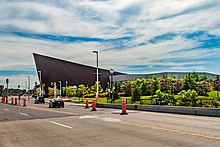Canadian War Museum
[3] Established with the intention to be a museum of national interest, the institution sought to preserve historical records and materials relating to the Canadian Militia, and any of its colonial predecessors.
[6] The collection from the Cartier Square Military Museum remained at the warehouse until Dominion Archivist, Arthur Doughty, requested the transference of the items to the archives to display some of them.
[12] A War Trophies Review Board was established between the archives and militia, charged with selecting the best items to preserve for a future museum.
"[17] Although the Canadian Museum of Civilization Corporation invested C$1.7 million for new exhibit designs as a result of the report; funds remained limited for expansion, with the federal government implementing a number of austerity measures during the mid-1990s.
[24] However, in 2001, Canadian Prime Minister Jean Chrétien intervened to have the proposed location changed to LeBreton Flats, a formerly industrial area of the city.
[29] Shortly after its opening of the new building, the museum became the centre of controversy over its interpretation of the Combined Bomber Offensive during World War II, in which some 20,000 Canadians participated.
The property is bounded by roadways to the east and south, by the Capital Pathway, and the southern banks of the Ottawa River to the west and north.
[35] Tilted and jagged planes, along with roughhewn materials are used throughout the building in a form of "controlled imperfection", intended to create the impression of trauma and disequilibrium.
[37] A 20,500 square metres (221,000 sq ft) self-seeding green roof, which connects to the surrounding parkland and riverfront, is also situated on the rooftop of the building.
[33] The roof was designed to mimic the urban development of the area, with the western portions of the rooftop closer to the rural areas of Ottawa designed to blend in with the surrounding parkland, while the eastern portion closer to downtown Ottawa features sloped concrete slopes that provide visitors with a view into the museum from the rooftop.
[34] Other educational facilities within the building include the Military History Resource Centre, a museum library and archive; and the 236-seat Barney Danson Theatre.
[34] The exhibition areas in the museum feature austere lines of galvanized steel, concrete, wood, and other hard surfaces with strong, and deep colours.
[43] The galleries were intended to "enhance the human experiences of war," documenting moments in Canadian military history that helped shape the country; with many of the exhibits drawing links to the events with larger themes of nationhood and national identity.
The South African and the First World War gallery is styled to resemble Canada during Queen Victoria's diamond jubilee in 1897; intended to mimic the imperialistic fervour that existed during that period.
[49] Most of the Second World War exhibit focuses on Canada's role in the Battle of the Atlantic, the British Commonwealth Air Training Plan, the European theatre, the homefront and the internment of Japanese Canadians.
[52] The gallery also houses an M4 Sherman tank named Forceful III, and is dedicated to the members of the Governor General's Foot Guards killed during the Second World War.
[45][55] In 2017, the concluding portion of the fourth gallery was updated to include post-Cold War conflicts involving members of the Canadian Armed Forces.
[26] Equipment is organized into several sections, land, air, sea, field artillery, armoured fighting vehicles, cannon or mortar, and tanks.
[61] The equipment housed in LeBreton Gallery is among the largest items in the museum's collections and includes a McDonnell CF-101 Voodoo, 19th-century artillery pieces, tanks, and other military vehicles.
[26] The exhibit is illuminated by a skylight which extends beyond from the building's rooftop; while a glass-enclosed pool of water sits on the south side of Memorial Hall.
[25] Regeneration Hall is an exhibition located at the highest point of the museum building serving as a "physical representation of hope for a better tomorrow".
[63] The walls of Regeneration Hall are angled in a manner similar to the buildings on Parliament Hill, with the Peace Tower visible through the eastern glass façade of the exhibition.
[39] The exhibition holds several artworks, including the original models for the Canadian National Vimy Memorial, and the painting Sacrifice by Charles Sims.
[26] The original plaster model that was submitted and later chosen in the National War Memorial design competition is exhibited in the centre of the Hall of Honour.
[26][64] Floor-to-ceiling display cases containing certificates of service, letters, medals, models, paintings, photographs, rolls of honour, scrapbooks, and souvenirs are situated along the walls of the exhibit.
[26] The exhibits are displayed chronologically and include items relating to First Nations, New France, British North America, and confederated Canada.
[26] Items in these displays, along with the individual stories corresponding to each chronological period are exhibited in an attempt to convey the various forms of commemorating the war dead throughout Canadian history.
[9] Following the end of World War II in Europe, the museum dispatched its first collections acquisition team to the Netherlands and Allied-occupied Germany to acquire a large number of German military equipment.
[65] Other artists featured in the collection include Caroline Armington, Alfred Bastien, Charles Comfort, Alma Duncan, Colin Gill, Bobs Cogill Haworth, Robert Stewart Hyndman, Richard Jack, Frank Johnston, Manly E. MacDonald, Pegi Nicol MacLeod, Mabel May, Jack Nichols, Charles Sims, and Frederick Varley.
[64] The museum's collection also includes the original scale plaster models by Walter Seymour Allward for the Canadian National Vimy Memorial.





















